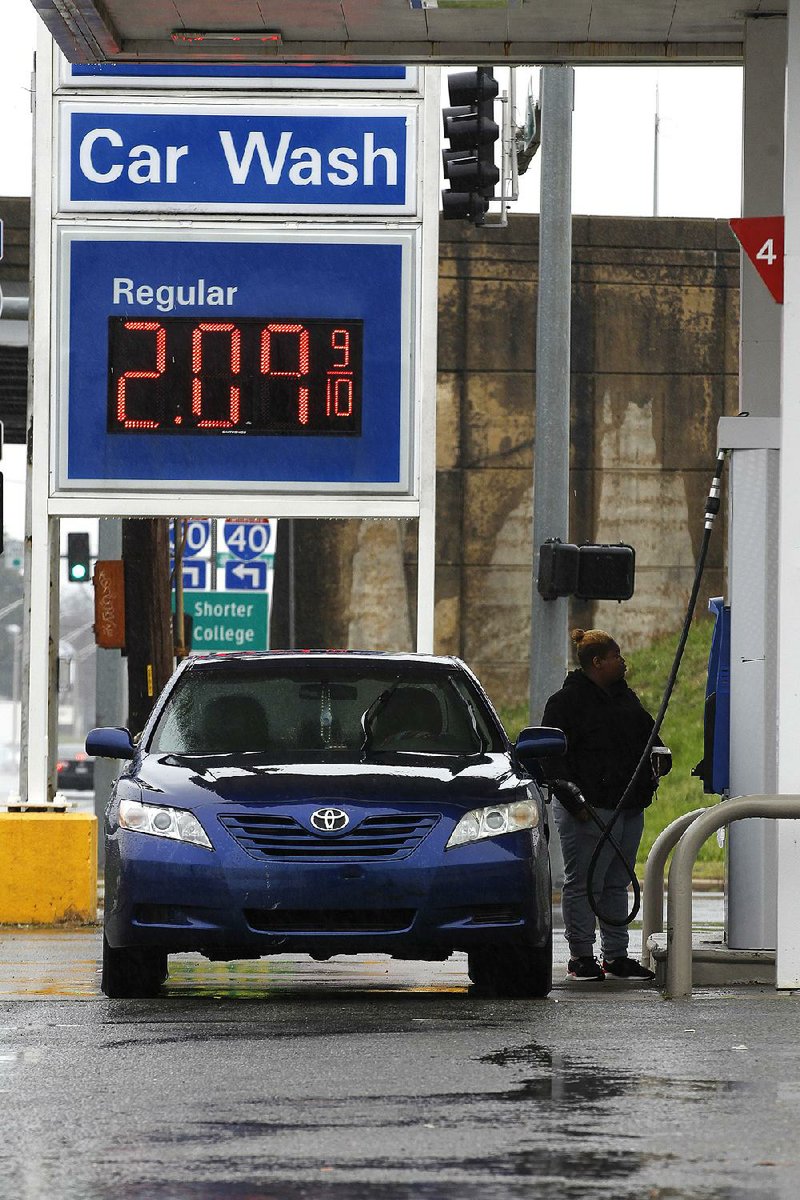Gasoline prices are on the rise in Arkansas and nationally, the result of refinery issues, rising crude oil prices and tighter crude inventories, according to reports.
The average pump price in Arkansas on Thursday was just under $2.11, according to auto club AAA, a 12-cent jump from a week ago. Gas prices across the nation rose more than a nickel this week compared with last week, pushing the national average up to $2.37 a gallon, according to AAA data.
Jeanette Casselano, a spokesman for AAA, said in remarks to reporters that the factors pressuring prices will likely "keep gas prices higher through the end of the month."
While Arkansas saw a sharp price increase, Michael Pakko, chief economist at the Arkansas Economic Development Institute at the University of Arkansas at Little Rock, said the state's gas prices remain some of the lowest in the nation.
Arkansas motorists were paying an average of $1.92 a gallon a month ago.
"It's basically a result of severe and frigid weather that hit the Midwest," which caused refineries to go offline, coupled with a seasonal drop in demand, Pakko said.
He said consumers can probably absorb the increases in the short term.
"Relatively speaking we are not suffering much in that regard," he said.
The nation's average gas price rose 6 cents to $2.33 in the week ending Tuesday. AAA said in a news release that it was the largest one-week increase at the national level this year.
Mervin Jebaraj -- director of the Center for Business and Economic Research at the Sam M. Walton College of Business at the University of Arkansas, Fayetteville -- said some domestic refineries are dealing with lower capacities as many undergo regular and nonroutine maintenance cycles, which has cut supply and pushed up prices.
Also, the Organization of Petroleum Exporting Counties "cut supply a while back and that takes a while to flow through and affect us," Jebaraj said.
West Texas Intermediate crude oil, the national benchmark, slid 0.3 percent Thursday to settle at $56.96 a barrel in New York. Crude prices have rallied nearly 25 percent since the start of the year, according to the Nasdaq commodity market.
Trade talks' effect
Another factor in the mix is the ongoing trade talks between the U.S. and China, which could improve the global economic outlook and spur demand if a trade resolution is met. However, Jebaraj said "no one knows where they are on that."
Looking ahead, he predicts that the gas price gains are temporary "given these are maintenance issues going on," which won't affect motorists or businesses much in the long-run.
"But if these 10-cent, 20-cent price increases persist, consumers will feel the pinch," Jebaraj said. "Eating out often gets cut first, then groceries and so on" at the micro-level.
On a broader scale, oil price increases coincide with higher inflation and a reduction in economic growth, according to a report from the Federal Reserve Bank of San Francisco. Oil prices directly affect the price of petroleum-made products. As a result, businesses often pass the production costs on to the consumer.
Pakko said if high gas prices persist, they can also affect life decisions, like whether to book a flight or take a long family vacation.
According to AAA, states in the south and southeast have seen gas prices rise by at least a dime since last week. Data show the 10 largest weekly increases, as of Tuesday, were in Michigan (16 cents); Oklahoma (12 cents); Minnesota (11 cents); Texas (11 cents); Kansas, Arkansas and Delaware (10 cents); and Maryland, Iowa and Kentucky (9 cents).
The national average has risen more than 4 cents since Tuesday, and the Arkansas average was up 3 cents. However, data show average prices remain lower than a year ago. The national average price per gallon was $2.52 this time last year, and the Arkansas average was $2.31.
Rural counties in north and southwest Arkansas saw the highest retail gas prices, while the metropolitan areas and southeast parts of the state saw some of the lowest, according to the AAA.
Montgomery County west of Hot Springs reported the highest average: $2.33 per gallon. Drew County just south of Monticello reported the lowest: $2.02.
Residents in the metropolitan areas saw average gas prices rise as much as 8 percent from a week ago, data show.
The Little Rock-North Little Rock area, the Fayetteville-Springdale-Rogers area and the Texarkana area all saw gas prices rise nearly 7 percent from last week. Prices rose more than 6 percent in Fort Smith, Jonesboro and West Memphis.
The Hot Springs area saw gas prices rise nearly 8 percent from last week to an average of $2.06 a gallon.
The Pine Bluff area saw gas prices rise more than 4 percent from last week to $2.10 a gallon.
A Section on 02/22/2019
